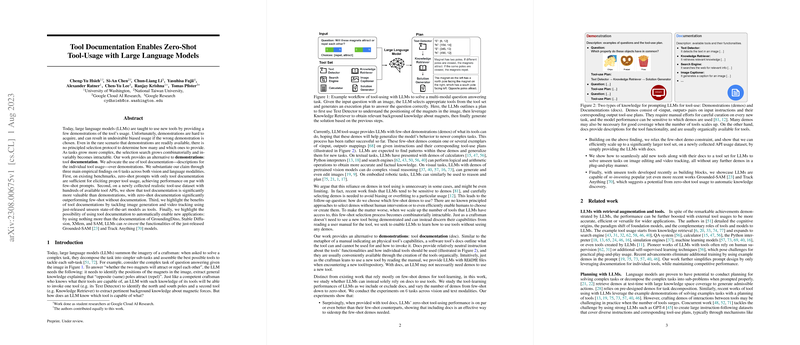Tool Documentation Enables Zero-Shot Tool Usage with LLMs
The paper "Tool Documentation Enables Zero-Shot Tool-Usage with LLMs" explores the utility of tool documentation as an alternative to few-shot demonstrations in enabling LLMs to effectively use external tools. This paper highlights the potential for LLMs to harness tool documentation to perform tasks without the need for specific examples or demonstrations, thus emphasizing a shift towards leveraging documentation over curated few-shot examples. Three primary findings underscore this approach's efficacy across six tasks, encompassing both vision and language modalities.
A key insight discussed in the paper is that zero-shot prompts, which rely exclusively on tool documentation, can achieve tool-using performance comparable to that of few-shot prompts. This is particularly evident across existing benchmarks, where the reliance on few-shot demonstrations is reduced without performance degradation. The analysis indicates that tool documentation, which naturally accompanies tools as descriptions of their functionalities, serves as a robust framework for the LLMs to understand and utilize new tools effectively. For instance, in tasks such as ScienceQA, TabMWP, and NLVRv2, the authors report performance results where zero-shot prompts with documentation rival or outperform their few-shot counterparts.
The authors also introduce a dataset, the LLM Cloud CLI, featuring hundreds of tools in the form of command-line interfaces, to analyze the scalability of tool documentation. In this new dataset, leveraging tool documentation demonstrates a significant performance increase over purely few-shot approaches. Results show that the application extrapolated on a large set of commands underscores the scalability of the documentation approach.
The paper further illustrates the benefits of tool documentation by tackling novel tasks such as image editing and video tracking using just-released vision models, including GroundingDINO, Segment Anything Model (SAM), and XMem. In such scenarios, LLMs employ this documentation to piece together tools that allow the re-creation of functionalities inherent in newly released models like Grounded-SAM and Track Anything, effectively replicating these advanced techniques through zero-shot utilization.
This research presents significant implications for the future of AI applications and tool usages with LLMs. The innovation in zero-shot tool usage driven by documentation can seamlessly integrate new functionalities into existing systems without requiring exhaustive retraining or fine-tuning steps. Practical applications could include robust plug-and-play systems where LLMs could dynamically select and use tools solely based on reading their documentation, a potentially transformative approach in automating and augmenting workflows across industries reliant on AI technologies.
However, as with any pioneering approach, challenges remain. Notably, the quality of tool documentation varies significantly, and the effectiveness of zero-shot usage is tied to the thoroughness of these docs. There is also the issue of handling large inputs, which could be exacerbated when dealing with extensive documentation, posing computational constraints on the LLMs.
Future research may focus on enhancing documentation parsing methods, improving the handling of lengthy documents, and further exploring the limits of zero-shot tool usage. As AI models grow more sophisticated, tool documentation could become foundational, offering a scalable, versatile method of integrating diverse tools into AI systems, thus broadening the scope of automated language understanding and reasoning capabilities.
